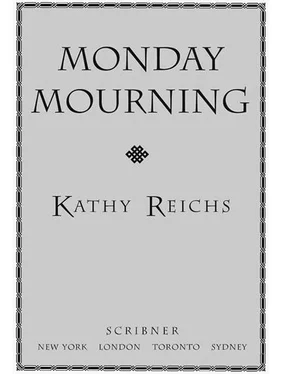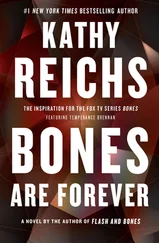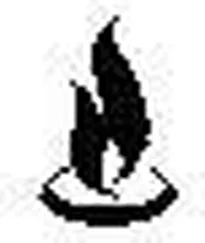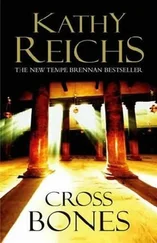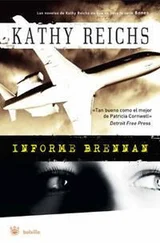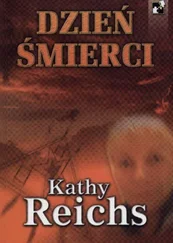Kathy Reichs - Monday Mourning
Здесь есть возможность читать онлайн «Kathy Reichs - Monday Mourning» весь текст электронной книги совершенно бесплатно (целиком полную версию без сокращений). В некоторых случаях можно слушать аудио, скачать через торрент в формате fb2 и присутствует краткое содержание. Жанр: Старинная литература, на английском языке. Описание произведения, (предисловие) а так же отзывы посетителей доступны на портале библиотеки ЛибКат.
- Название:Monday Mourning
- Автор:
- Жанр:
- Год:неизвестен
- ISBN:нет данных
- Рейтинг книги:4 / 5. Голосов: 1
-
Избранное:Добавить в избранное
- Отзывы:
-
Ваша оценка:
- 80
- 1
- 2
- 3
- 4
- 5
Monday Mourning: краткое содержание, описание и аннотация
Предлагаем к чтению аннотацию, описание, краткое содержание или предисловие (зависит от того, что написал сам автор книги «Monday Mourning»). Если вы не нашли необходимую информацию о книге — напишите в комментариях, мы постараемся отыскать её.
Monday Mourning — читать онлайн бесплатно полную книгу (весь текст) целиком
Ниже представлен текст книги, разбитый по страницам. Система сохранения места последней прочитанной страницы, позволяет с удобством читать онлайн бесплатно книгу «Monday Mourning», без необходимости каждый раз заново искать на чём Вы остановились. Поставьте закладку, и сможете в любой момент перейти на страницу, на которой закончили чтение.
Интервал:
Закладка:
LaManche sighed and pulled his ear. “Monsieur Claudel also told me that the building is more than a hundred years old.”
“Claudel has researched the property?” I felt heat flush my face. “He has not shared that information with me.”
“Construction took place over a century ago.”
I have a flash point temper. My father’s temper. Along with drink, Daddy’s fury sometimes ruled him. I grew up with the impact of those outbursts.
Like Daddy, I succumbed to the lure of the bottle. Unlike him, I walked away from booze. Also unlike him, I learned to control my temper. When fire simmers inside, outside I grow deadly calm.
“Did Monsieur Claudel not realize that such information is relevant to my task?” I asked, my voice glacial.
“I am certain he will inform you in detail.”
“During my lifetime?”
“Do not grow defensive. I am not fighting you.”
I drew a deep breath.
“There is one test which might resolve the question.”
“Tell me.”
“You’ve heard of Carbon 14 dating?”
“I know it is used to assign age to organic materials, including human bone. I do not know how it works.”
“Radiocarbon, or Carbon 14, is an unstable isotope. Like all radioactive substances, it decays by releasing subatomic particles at a uniform rate.”
LaManche’s eyes stayed heavy on mine.
“In about 5,730 years half of a population of radiocarbon atoms will have reverted to nitrogen.”
“That is the half-life.”
I nodded. “After 11,460 years, a fourth of the original amount of radiocarbon remains. After another 5,730 years, only an eighth remains, and so on.”
LaManche did not interrupt.
“The amount of radiocarbon in the atmosphere is really tiny. There’s only about one radiocarbon atom for every trillion stable carbon atoms. Radiocarbon is constantly being created in the upper atmosphere by cosmic bombardment of nitrogen. Some of the nitrogen converts to radiocarbon, which immediately oxidizes to CO 2. That CO 2works its way down into the biosphere, where it’s taken up by plants. Since humans, animals, and plants comprise the same food chain, as long as they are alive they have a constant amount of radiocarbon in them. The actual amount is gradually decreasing due to radioactive decay, but is being replenished through food intake, or through photosynthesis in the case of plants. This equilibrium exists as long as an organism is alive. When it dies, decay becomes the only active process. Radiocarbon dating is a method that determines the point in time at which this disequilibrium started.”
LaManche raised both palms in a gesture of skepticism. “Five-thousand-plus years. How can such a slow process be of value with recent remains?”
“A fair question. It’s true that Carbon 14 dating has been used primarily by archaeologists, and has been shown to be quite reliable. But the technique is based on a number of assumptions, one of which is that the atmospheric level of radiocarbon has remained constant over time. Data inconsistent with that assumption can actually be used to give the process wider applicability.”
“How so?”
“That’s where it gets interesting. Studies have documented significant anomalies in radiocarbon data for certain time periods. Two perturbations have taken place over the past eighty years, both of which were caused by human activity.”
LaManche leaned back, interlaced his fingers, and laid his hands on his chest. A hint for brevity? I did some mental abridgment.
“The period from about 1910 to 1950 is characterized by a decrease of atmospheric radiocarbon, probably due to the release into the atmosphere of the products of combustion of fossil fuels such as oil, coal, and natural gas.”
“Why?”
“Because of their great age, fossil fuels contain no detectable radiocarbon. They are said to be dead. Since the combustion of these fuels releases carbon dioxide devoid of radiocarbon, the relative amount of Carbon 14 in the atmosphere drops.”
“Oui.”
“But beginning about 1950, the atmospheric testing of thermonuclear weapons reversed this downward trend.”
“The radiocarbon in living things increased.”
“Dramatically. From 1950 to 1963, the values rose to about 85 percent above contemporary reference levels. In 1963, an international agreement halted atmospheric nuclear testing by most nations, and biospheric radiocarbon levels began settling into a new equilibrium.”
“Such folly.” LaManche wagged his head sadly.
“These permutations are known as the fossil fuel and atomic bomb effects.”
LaManche stole a glance at his watch.
“The bottom line is that artificial or ‘bomb’ Carbon 14 can be used to determine if someone died before or after the period of atmospheric nuclear testing.”
“How is this test done?”
“There are actually two methods. With the standard radiometric technique, materials are analyzed by synthesizing the sample carbon to benzene, then measuring the Carbon 14 content in a scintillation spectrometer.”
“And the other method?”
“With the other method results are derived from reduction of the sample carbon to graphite. The graphite is then tested for Carbon 14 content in an accelerator mass spectrometer.”
For several seconds LaManche said nothing. Then, “How much bone is required?”
“For conventional decay counting, two hundred fifty grams. For accelerator mass spectrometry, just a gram or even less.”
“AMS testing costs more?”
“Yes.”
“How much?”
I told him.
LaManche removed his glasses and squeezed the bridge of his nose with a thumb and forefinger.
“Is there no intermediate step to determine that such an expenditure is justified?”
“There’s one thing I could try. The technique isn’t terribly reliable, but it’s simple and might show if death occurred more or less than a hundred years ago.”
LaManche started to speak.
“And free,” I added. “I can do it myself. But again, it will yield only a very rough indication of whether the bones are more or less than a century old.”
“Please.” LaManche repositioned his glasses and rose. “In the meantime I will discuss your proposal with Dr. Authier.”
Jean-François Authier, the chief coroner, considered all requests for exceptional expenditures. Few were granted.
Grabbing a lab coat from my office, I headed to the morgue. Morin and Ayers were already cutting Y incisions in room two. I requested a UV light, and waited while the tech got it. Then I hurried to the appropriate bay and pulled the left femora from skeletons 38426, 38427, and 38428.
In autopsy room four, I wrote the respective case numbers on the proximal and distal ends of the leg bones, and placed them on the autopsy table. Each made a soft thunk in the stillness.
After masking, I plugged in and revved a Stryker saw. White powder coned on the stainless steel as I bisected each femoral shaft. A hot, acrid odor filled the air.
I wondered again about the young women whose bones I was cutting. Had they died surrounded by family? Probably not. Alone and frightened? More likely. Hopeful of rescue? Desperate? Angry? Relieved? All possible. They never get to say.
When I’d finished sawing, I gathered the femoral segments and the UV light, and carried them to a storage closet at the end of the hall.
Come on. Let this work.
Entering the closet, I located an outlet and plugged in the UV. Then I set the femoral halves on a shelf with their freshly sawn surfaces facing outward.
When I closed the door, it was pitch-black.
Barely breathing, I pointed the UV and thumbed the switch.
8
“YES!” MY FREE HAND PUMPED THE AIR.
Читать дальшеИнтервал:
Закладка:
Похожие книги на «Monday Mourning»
Представляем Вашему вниманию похожие книги на «Monday Mourning» списком для выбора. Мы отобрали схожую по названию и смыслу литературу в надежде предоставить читателям больше вариантов отыскать новые, интересные, ещё непрочитанные произведения.
Обсуждение, отзывы о книге «Monday Mourning» и просто собственные мнения читателей. Оставьте ваши комментарии, напишите, что Вы думаете о произведении, его смысле или главных героях. Укажите что конкретно понравилось, а что нет, и почему Вы так считаете.
